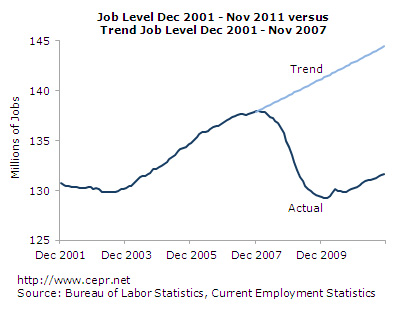December 02, 2011
Dec 2, 2011 (Jobs Byte)
By Dean Baker
The employment rate for women is down 0.7 percentage points from its year-ago level.
The Labor Department reported a decline of 315,000 people in the labor market in October. This was the main factor driving a drop of 0.4 percentage points in the unemployment rate to 8.6 percent. The establishment survey showed a weaker-than-expected 120,000 job gain for the month; although this bad news was largely offset by upward revisions of 72,000 to the job growth numbers for the prior two months.
The drop in participation was entirely among women and especially black women. (Among married women, employment rose by 194,000, so this was not a case of women as second earners dropping out of the labor force.) Participation numbers among white women fell by 199,000, a decline of 0.2 percentage points. The drop among black women was 164,000, a drop of 1.2 percentage points. These monthly numbers are highly erratic, and it is likely that at least part of this drop will be reversed in future months. Nonetheless there had been a trend of declining participation rates among both white and black women even prior to the November plunge. This suggests that there is a real issue of women losing access to jobs; although the December figures may show some reversal.
Other data in the household survey were mixed. The number of workers involuntarily employed part-time fell by 378,000, its second consecutive large monthly drop. However, the duration measures all increased, with the average duration hitting 40.9 weeks, a new high for the downturn. The percentage of the unemployed who voluntarily quit their jobs fell slightly from the October level, but at 7.6 percent it is still higher than it has been since the very beginning of 2009. This presumably reflects some increase in confidence about job prospects.
The picture on the establishment survey is not strong. While the 120,000 job growth reported for November is enough to keep pace with the growth of the labor force, many of these jobs (49,800) were in the retail sector. This growth in this sector was likely inflated by earlier-than-usual hiring for the holiday season as stores put more of a premium on Black Friday sales. Employment in clothing stores jumped by 26,700, or 1.9 percent, in November. If this is the case, retail employment will be unusually weak in December.
There were few other sectors with notable job growth for the month. The temp sector added 22,300 workers, slightly more than the 14,000 average over the last year, but hardly a signal of robust hiring down the road. Restaurants added 32,700 workers, bringing the average over the last three months to 27,300. That is somewhat faster than the average of 17,500 over the last year. Health care added just 17,200 jobs, down from an average of almost 30,000 a month over the last year.
Construction employment fell for the second consecutive month leaving it little changed from the year-ago level. Manufacturing employment was virtually unchanged in November. Growth over the last year has averaged 9,000 a month.
The government sector shed another 20,000 jobs, with 16,000 of the lost jobs being at the state and local level. The government sector has lost 278,000 jobs over the last year.
Average weekly hours remained unchanged. The average workweek is just 0.1 hour above the year-ago level. This suggests that employers are having no problems finding qualified workers, because if they were, they would be increasing hours per worker. There is also little change in wage patterns with the average hourly wage rising at 1.7 percent rate over the last year.

The overall employment picture for November looks quite bleak with the weak growth in jobs and the reported drop in labor force participation. However, it is likely that the latter was simply an erratic fluctuation in the data. The establishment survey is by far the more reliable measure. Over the last three months, overall job growth has averaged 143,000. It takes roughly 90,000 jobs to keep even with the growth of the labor force. At this rate, it will take close to 200 months, or 16 years, to make up for the 10-million-job deficit in the economy.






